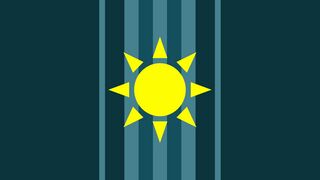New Altnavia (Pacifica): Difference between revisions
mNo edit summary |
mNo edit summary |
||
| Line 37: | Line 37: | ||
[[File:New Altnavia, 1600 BCE.jpg|thumb|After the Great Deforestation]] | [[File:New Altnavia, 1600 BCE.jpg|thumb|After the Great Deforestation]] | ||
The three ancient kingdoms, Decidilia, Luxideis and Servipilo, grew a lot in population as small tribes between the kingdoms joined them and better farming methods were developed. The most populous, Decidilia is thought to have had over 120 thousand people, which is a lot considering the climate and size of the kingdom. Because of the growing population, more land was needed but the nations were surrounded by the ocean and rainforests. In 1730s BCE, mass deforestation started in modern day Ineopbi by Decidilians. This spread to other regions and other kingdoms and an incredible amount of trees were taken down. This event ended around 1610 BCE, and the kingdoms had grown by an immense amount. | The three ancient kingdoms, Decidilia, Luxideis and Servipilo, grew a lot in population as small tribes between the kingdoms joined them and better farming methods were developed. The most populous, Decidilia is thought to have had over 120 thousand people, which is a lot considering the climate and size of the kingdom. Because of the growing population, more land was needed but the nations were surrounded by the ocean and rainforests. In 1730s BCE, mass deforestation started in modern day Ineopbi by Decidilians. This spread to other regions and other kingdoms and an incredible amount of trees were taken down. This event ended around 1610 BCE, and the kingdoms had grown by an immense amount. | ||
==== Enneidi Era (1610 BCE ~ 1044 BCE) ==== | |||
[[File:NALTN 1350BCE.jpg|thumb|1350 BCE, during the Enneidi Era]] | |||
The Enneidi Era began as the Great Deforestation ended. Small deforestation events continued to happen. New nations, known as the Second Generation Bronze Age States were founded. | |||
By 1350 BCE, the nations had control of all the current New Altnavian territory except for Nealta. The five states had peaceful relations for the first two centuries, but started to have wars with one another. | |||
===== Desadeifa (1542 BCE ~ 1086 BCE) ===== | |||
Desadeifa was founded in modern day Hurudeifa in 1542 BCE by some tribes that lived in the region. At first, it was ruled by a king. However, in 1404 BCE, the king was overthrown and the first republic in the history of New Altnavia was founded. However, there are historians that claim that there was no republic and a new king ruled the nation. | |||
The so-called republic fell in 1383 BCE, and Desadeifa became a kingdom again. Since about then, it had good relations with Decidilia. The two nations helped each other until 1102 BCE, when King Helideira became the king of Decidilia. He did not attack Desadeifa, but refused to continue the good relationship between the nations. | |||
Desadeifa was invaded and conquered by the Kingdom of Luxideis in 1086 BCE. | |||
=== Ancient Kingdoms ( ~ 693) === | === Ancient Kingdoms ( ~ 693) === | ||
| Line 50: | Line 63: | ||
==== The Fall of Nealta (1831) ==== | ==== The Fall of Nealta (1831) ==== | ||
=== First Republic (1905 ~ 1954) === | === First Modern Republic (1905 ~ 1954) === | ||
==== Derisli Government (1905 ~ 1937) ==== | ==== Derisli Government (1905 ~ 1937) ==== | ||
Revision as of 10:23, 8 September 2024
New Altnavia, officially The Democratic Republic of New Altnavia (Pur Ramaedtra Velisia lo Alisi Altineivio) is a unitary state located in northern Bailtem. It is bordered to the east by Andrendia, to the south by Amberholde, Kustannuksa, Dacian Federation and to the west by People’s Republic of San Marsico. The nation’s current leaders are President Christopher Semili Ideipi and Prime Minister James Caliderei Pelidi. The capital and largest city of the nation is Noveopolis.
The Democratic Republic of New Altnavia | |
|---|---|
|
Flag | |
Motto: Together as one, we build a path to the better ‘neivio’ (peaceful seaside) | |
Anthem: The Light Over The East Horizon | |
| Capital | Noveopolis |
| Official languages | Pacicayan, Silivian and Austral |
| Ethnic groups | Pacicayan 55.2%
Silivian 29.8% Nealti 10.1% Other 4.9% |
| Government | |
• President | Christopher Semili Ideipi |
• Prime Minister | James Caliderei Pelidi |
| Area | |
• Total | 270,328 km2 (104,374 sq mi) |
| Population | |
• Census | 53,408,900 (2023.07) (16) |
• Density | 198/km2 (512.8/sq mi) |
| Currency | Viliceide (VCD) |
| Time zone | UTC +2 |
| Date format | YYYY/MM/DD |
| Driving side | right |
| Calling code | +174 |
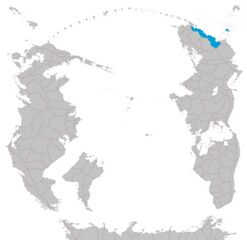 | |
The nation consists of 8 provinces on the mainland of the continent Bailtem and three islands. Most of the nation has a tropical climate. The current republic was founded in September 2022, a month after the former King Laleikiya (1911~2022) passed away with no successors. New Altnavia has a population of 53.4 million, making it the 16th most populous nation in the South Pacific. The official languages of New Altnavia are Pacicayan, Silivian and Austral with Pacicayan being the most well-known language throughout the nation. 95.1% of the people of the nation are from the three main ethnic groups, which are Pacicayan, Silivian and Nealti.

The Pacicayan people are native to the modern-day Sudu Capitalia, Greater Noveopolis, Ineopbi (pronounced ee-nay-yo-bee), Hurudeifa, Fipotalla and North Fipotalla. The Silivians are native to Nodeiso, Silivo and Viruidi Island while the Nealti are native to the region called New East Altnavia.
Etymology
The name ‘New Altnavia’ comes from the kingdom’s name that existed until 2022, which had the same territory as the current republic, called Altineivio Kingdom. In the name ‘Altineivio’, ‘alti’ means ‘beautiful’ in Silivian and ‘neivio’ means ‘peaceful seaside’ in Pacicayan.
History
Prehistory
Exactly when the first humans settled in the modern-day mainland New Altnavia is unknown. It is thought that the event happened 90-150 thousand years ago. The oldest artifacts were discovered along the Pacicaya River, Fipotalla River and Silivo River. Humans gathered to make small towns consisting of about 120 people on average. The small towns traded and fought with one another. These towns are not considered nations as they had a small number of people and didn’t have a proper government.
Bronze Age States (1887 BCE ~ 342 BCE)
The ‘Bronze Age States’ refers to the nations that existed between 1887 BCE, when Decidilia was founded, and 342 BCE, when iron weapons spread as Later Luxideis was conquered.
The First Kingdoms
In the 1900s BCE, towns along the Pacicayan River started to either unite with each other or invade and annex one another. The Kingdom of Decidilia is said to have been founded along the Pacicayan River in 1887 BCE.
At similar times, similar things happened along the river banks of Silivo and Fipotalla. The Kingdom of Luxideis was founded along the Fipotalla River in 1863 BCE and the Kingdom of Servipilo was founded along the Silivo River in 1824 BCE. The three kingdoms continued to extend their borders, annexing small settlements around them.
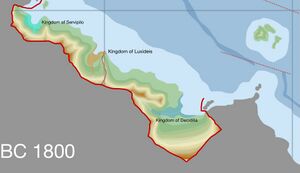
By 1800 BCE, the kingdoms had over 90% of the total population in mainland New Altnavia. They developed cultures, including their own scripts and architecture styles. The land between the nations was mostly taken up by dense rainforests and the forests blocked the kingdoms from extending their territory a lot. Moving through the forests was not easy. However, the kingdoms often traded with and helped one another in many ways and managed to have peaceful relations for several centuries. These few centuries are known as the most peaceful times in all of New Altnavian history.
The Great Deforestation and Territory Extension
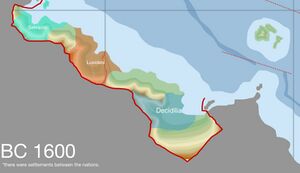
The three ancient kingdoms, Decidilia, Luxideis and Servipilo, grew a lot in population as small tribes between the kingdoms joined them and better farming methods were developed. The most populous, Decidilia is thought to have had over 120 thousand people, which is a lot considering the climate and size of the kingdom. Because of the growing population, more land was needed but the nations were surrounded by the ocean and rainforests. In 1730s BCE, mass deforestation started in modern day Ineopbi by Decidilians. This spread to other regions and other kingdoms and an incredible amount of trees were taken down. This event ended around 1610 BCE, and the kingdoms had grown by an immense amount.
Enneidi Era (1610 BCE ~ 1044 BCE)
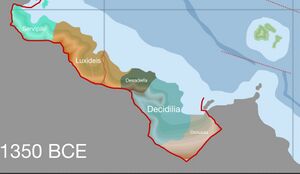
The Enneidi Era began as the Great Deforestation ended. Small deforestation events continued to happen. New nations, known as the Second Generation Bronze Age States were founded.
By 1350 BCE, the nations had control of all the current New Altnavian territory except for Nealta. The five states had peaceful relations for the first two centuries, but started to have wars with one another.
Desadeifa (1542 BCE ~ 1086 BCE)
Desadeifa was founded in modern day Hurudeifa in 1542 BCE by some tribes that lived in the region. At first, it was ruled by a king. However, in 1404 BCE, the king was overthrown and the first republic in the history of New Altnavia was founded. However, there are historians that claim that there was no republic and a new king ruled the nation.
The so-called republic fell in 1383 BCE, and Desadeifa became a kingdom again. Since about then, it had good relations with Decidilia. The two nations helped each other until 1102 BCE, when King Helideira became the king of Decidilia. He did not attack Desadeifa, but refused to continue the good relationship between the nations.
Desadeifa was invaded and conquered by the Kingdom of Luxideis in 1086 BCE.
